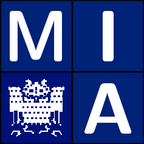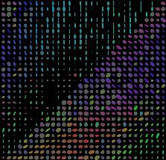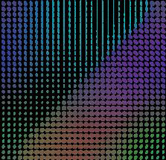
Image Processing of Tensor Fields
Home
About Us
People
Teaching
Research
Publications
Awards
Links
Contact
Internal

|

|
Matrix-valued data sets (so-called tensor fields) are gaining increasing importance in digital imaging. This has been triggered by the following developments:
- Novel medical imaging techniques such as diffusion tensor magnetic resonance imaging (DT-MRI) have been introduced. DT-MRI is a 3-D imaging method that yields a diffusion tensor in each voxel. This diffusion tensor describes the diffusive behaviour of water molecules in the tissue. It can be represented by a positive semidefinite 3 x 3 matrix in each voxel.
- Tensors have shown their use as a general tool in image analysis, segmentation and grouping. This also includes widespread applications of the so-called structure tensor in fields ranging from motion analysis to texture segmentation.
- A number of applications in science and engineering produce tensor fields: The tensor concept is a common physical description of anisotropic behaviour, especially in solid mechanics and civil engineering (e.g. stress-strain relationships, inertia tensors, diffusion tensors, permittivity tensors).
In our group we have developed a number of novel image processing methods that work directly on tensor fields:
- Anisotropic Diffusion Filters for Tensor Fields
We have proposed tensor-valued anisotropic diffusion filters. These filters use a diffusion tensor that allows to smooth preferently along discontinuities of the tensor field, while smoothing across discontinuities is inhibited. We have shown that suitable discretisations of these processes preserve the positive semidefiniteness of the initial tensor fields [1], [16]. -
Anisotropic Tensor-Valued Regularisation Methods
Novel energy functionals have been presented for the variational restoration of noisy tensor fields. Their Euler-Lagrange equations can be regarded as fully implicit time discretisations of tensor-valued anisotropic diffusion filters [1]. -
Nonlinear Structure Tensor
The structure tensor is a classical tool in image processing and computer vision (Förstner/Gülch 1987, Rao/Schunck 1990, Bigün et al. 1991). It averages orientations by means of Gaussian smoothing of all tensor channels. This may be regarded as tensor-valued linear diffusion filtering. In order to allow preservation of discontinuities, we have replaced this linear diffusion process by a nonlinear tensor-valued diffusion [1], [10]. Applications in the fields of optical flow estimation [2], texture analysis [3], and segmentation [4,5], demonstrate the favourable performance of the resulting nonlinear structure tensor. A comparison and evaluation of the nonlinear structure tensor in the context of other adaptive structure tensor concepts has been presented in [14]. -
Median Filtering of Tensor Fields
Median filters belong to the most popular nonlinear filters for image denoising. Usual median filters require an ordering of the input data. This is not possible in the tensor-valued setting. We have thus expoited another property of the scalar-valued median: The median minimises the sum of distances to all input data. This interpretation can be generalised to the matrix-valued case by considering distances induced by the Frobenius norm. The resulting median filter is robust under noise and preserves discontinuities of the tensor field [6]. Extensions and algorithmic aspects are discussed in [11], [18], [19]. -
Tensor-Valued Level Set Methods
We have proposed tensor-valued extensions of mean curvature motion, self-snakes and geodesic active contours. This is achieved by using information from a novel structure tensor for matrix fields. It sums up contributions from all tensor channels and may be regarded as a tensor-valued extension of Di Zenzo's edge detector for vector-valued data. We showed that tensor-valued mean curvature motion and geodesic active contours preserve positive semidefiniteness. Our experiments demonstrated that the tensor-valued level set methods inherit essential properties from their scalar-valued counterparts and that they are highly robust under noise, both in the two-dimensional [7] and three-dimensional setting [9]. See also the survey [16]. -
Tensor-Valued Morphology
Morphological operations that are based on dilation and erosion constitute one of the oldest and most successful branch in image processing. Since they are based on maximum and minimum operations, their generalisation to the tensor setting is not straightforward. In [8], [12], [15] we have proposed analytic and geometric extensions that preserve the positive definiteness of the initial data.
We were also involved in organising the Dagstuhl Workshop on Visualisation and Image Processing of Tensor Fields. The workshop led to a book [13] which is the first edited book covering visualisation and processing of tensor fields.
-
J. Weickert, T. Brox:
Diffusion and regularization of vector- and matrix-valued images.
In M. Z. Nashed, O. Scherzer (Eds.): Inverse Problems, Image Analysis, and Medical Imaging. Contemporary Mathematics, Vol. 313, 251-268, AMS, Providence, 2002. -
T. Brox, J. Weickert:
Nonlinear matrix diffusion for optic flow estimation.
In L. Van Gool (Ed.): Pattern Recognition. Lecture Notes in Computer Science, Vol. 2449, Springer, Berlin, 446-453, 2002. -
M. Rousson, T. Brox, R. Deriche:
Active unsupervised texture segmentation on a diffusion based feature space.
Technical report no. 4695, Odyssée, INRIA Sophia-Antipolis, France, 2003.
Slightly extended version of the conference paper with the same title,
Proc. 2003 IEEE Computer Society Conf. on Computer Vision and Pattern Recognition, Madison, WI, 2003. -
T. Brox, M. Rousson, R. Deriche, J. Weickert:
Unsupervised segmentation incorporating colour, texture, and motion.
In N. Petkov, M. A. Westenberg (Eds.): Computer Analysis of Images and Patterns. Lecture Notes in Computer Science, Vol. 2756, Springer, Berlin, 353-360, 2003. -
T. Brox, M. Rousson, R. Deriche, J. Weickert:
Unsupervised segmentation incorporating colour, texture, and motion.
Technical report no. 4760, Odyssée, INRIA Sophia-Antipolis, France, 2003. -
M. Welk, C. Feddern, B. Burgeth, J. Weickert:
Median filtering of tensor-valued images.
In B. Michaelis, G. Krell (Eds.): Pattern Recognition. Lecture Notes in Computer Science, Vol. 2781, Springer, Berlin, 17–24, 2003. -
C. Feddern, J. Weickert, B. Burgeth:
Level-set methods for tensor-valued images.
In O. Faugeras, N. Paragios (Eds.): Proc. Second IEEE Workshop on Variational, Geometric and Level Set Methods in Computer Vision. Nice, France, pp. 65-72. INRIA, Oct. 2003. -
B. Burgeth, M. Welk, C. Feddern, J. Weickert:
Morphological operations on matrix-valued images.
In T. Pajdla, J. Matas (Eds.): Computer Vision - ECCV 2004. Lecture Notes in Computer Science, Vol. 3024, Springer, Berlin, 155-167, 2004. -
C. Feddern, J. Weickert, B. Burgeth, M. Welk:
Curvature-driven PDE methods for matrix-valued images.
International Journal of Computer Vision, 2005, to appear.
Revised version of Technical Report No. 104, Department of Mathematics, Saarland University, Saarbrücken, Germany, April 2004.
-
T. Brox, J. Weickert, B. Burgeth, P. Mrázek:
Nonlinear structure tensors. Image and Vision Computing, to appear.
Revised version of Technical Report No. 113, Department of Mathematics, Saarland University, Saarbrücken, Germany, 2004.
-
M. Welk, F. Becker, C. Schnörr, J. Weickert:
Matrix-valued filters as convex programs.
In R. Kimmel, N. Sochen, J. Weickert (Eds.): Scale-Space and PDE Methods in Computer Vision. Lecture Notes in Computer Science, Vol. 3459, Springer, Berlin, 204–216, 2005.
-
B. Burgeth, N. Papenberg, A. Bruhn, M. Welk, C. Feddern, J. Weickert:
Mathematical morphology based on the Loewner ordering for tensor data.
In C. Ronse, L. Najman, E. Decencière (Eds.): Mathematical Morphology: 40 Years On. Computational Imaging and Vision, Vol. 30, Springer, Dordrecht, 407–418, 2005.
- J. Weickert, H. Hagen (Eds.):
Visualization and Processing of Tensor Fields.
Springer, Berlin, 2005, to appear.
- T. Brox, R. van den Boomgaard, F. Lauze, J. van de Weijer, J. Weickert, P. Mrázek, P. Kornprobst:
Adaptive structure tensors and their applications.
In J. Weickert, H. Hagen (Eds.): Visualization and Processing of Tensor Fields. Springer, Berlin, 2005, to appear.
Revised version of Technical Report No. 141, Department of Mathematics, Saarland University, Saarbrücken, Germany, 2005.
- B. Burgeth, M. Welk, C. Feddern, J. Weickert:
Mathematical morphology on tensor data using the Loewner ordering.
In J. Weickert, H. Hagen (Eds.): Visualization and Processing of Tensor Fields. Springer, Berlin, 2005, to appear.
- J. Weickert, C. Feddern, M. Welk, B. Burgeth, T. Brox:
PDEs for tensor image processing.
In J. Weickert, H. Hagen (Eds.): Visualization and Processing of Tensor Fields. Springer, Berlin, 2005, to appear.
Revised version of Technical Report No. 143, Department of Mathematics, Saarland University, Saarbrücken, Germany, 2005.
- J. Weickert, M. Welk:
Tensor field interpolation with PDEs.
In J. Weickert, H. Hagen (Eds.): Visualization and Processing of Tensor Fields. Springer, Berlin, 2005, to appear.
Revised version of Technical Report No. 142, Department of Mathematics, Saarland University, Saarbrücken, Germany, 2005.
- M. Welk, C. Feddern, B. Burgeth, J. Weickert:
Tensor median filtering and M-smoothing.
In J. Weickert, H. Hagen (Eds.): Visualization and Processing of Tensor Fields. Springer, Berlin, 2005, to appear.
- M. Welk, J. Weickert, F. Becker, C. Schnörr, C. Feddern, B. Burgeth:
Median and related local filters for tensor-valued images.
Technical Report No. 135, Department of Mathematics, Saarland University, Saarbrücken, Germany, 2005.
- J. Weickert, H. Hagen (Eds.):
MIA Group
©2001-2005
The author is not
responsible for
the content of
external pages.